
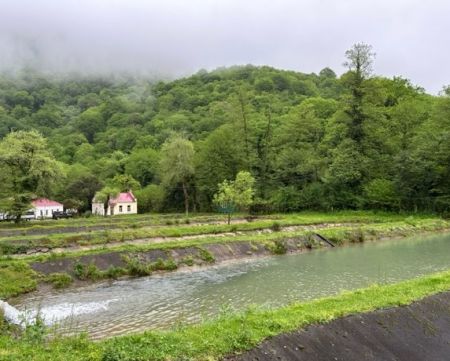
Every summer season, Russia and Abkhazia are connected by the “Sochi” excursion train. The unusual train was launched in 2020 and has already gained popularity with tourists and it has already carried 130,000 passengers. The train runs daily from Tuapse to Gagra, except for Tuesdays, and allows the passengers to pass the border without traffic jams and to turn back time as the train’s interior is decorated like it was in the USSR, and also to see the “Country of Soul” without any problems. Travellers can buy one of the seven excursions while they are going by train, and a gastronomic tour “Taste of Abkhazia” is an attraction of this year. The EcoTourism Expert correspondent was one of the first on this tour.
‘Good’ bees. Good honey
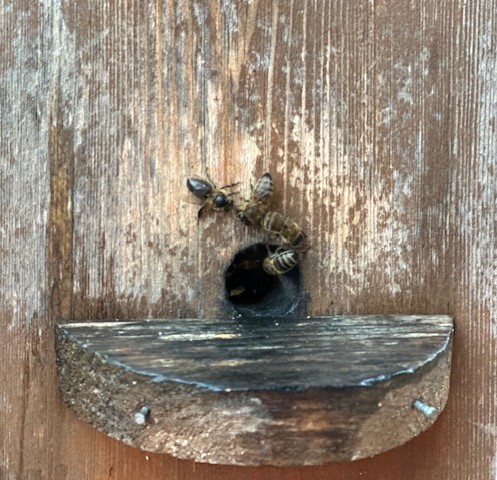
On the way to Lake Ritsa, giant bees appear suddenly against the backdrop of stunning green landscape and high mountains, like in a Hitchcock movie. This is a “Honey Yard”, the largest honey farm in Abkhazia, or it’s better to say, it’s a ‘showbeeyard’.
“Why is Abkhazian honey famous all over the world, why has it received prizes at international exhibitions many times? Because we have a wonderful environment. There are no industrial enterprises in the country at all. We have only two of them - a winery and a brewery, but they do not affect the environment but only put a smile on your face. Our main beegardens are located high in the mountains, and honey is not collected in the places where tourists and buses go, we only explain and show the tourists how it is done,” says the beekeeper Esnat Khvartskiya.
And Abkhazian honey is made by the ‘good’ bees - gray Caucasian ones. They have the longest proboscis in the world, it is more than seven millimetres long. Therefore, Abkhazian bees extract nectar from the deep parts of flowers.

“We collect honey according to the wild-hive beekeeping method as in ancient times. Wild-hive beekeepers in the old days were the people who found wild honey in old stumps, hollows of trees. Later, people began to make stumps, and to lure bees into them with the help of pollen. Such an ancient method of honey harvesting is used today only in the nature reserves of Bashkiria and Abkhazia,” - explains the beekeeper.
In the honey farms in the mountains, there are over three thousand beehive-stumps. During harvesting one crop of honey, each of them gives 70-80 kilogrammes of honey. Wild honey and apitonus are the best and tastiest. Wild honey is harvested once a year, it absorbs the taste of all flowers during 12 months - chestnut, blackberry, linden and other flowers, and tastes slightly bitter.
“In Abkhazia, we enjoy blossoming all year round. In winter, goldenrod blooms, mimosa blooms in February, then acacia, and so on. We don’t need to give sugar to our bees. Therefore, even diabetic patients can enjoy our Abkhazian honey,” says Esnat Khvartskiya.
Light apitonus honey is also very healthy, it is made from high-quality mountain honey, enriched with bee products like beebread, pollen and native royal jelly. By the way, the royal jelly is the most valuable product at any honey farm as it contains 22 of the 24 elements that are in human blood, the honey containing royal jelly cleans and rejuvenates the body. At the end of the tour of the bee yard, the beekeeper tells a little secret about how to understand that honey is real. It is a very simple way. It is enough to put a drop of honey on your hand and rub it. Real honey is absorbed by skin like a cream and it is not sticky, the one that contains sugar becomes like crumbs.
Cheese and wine
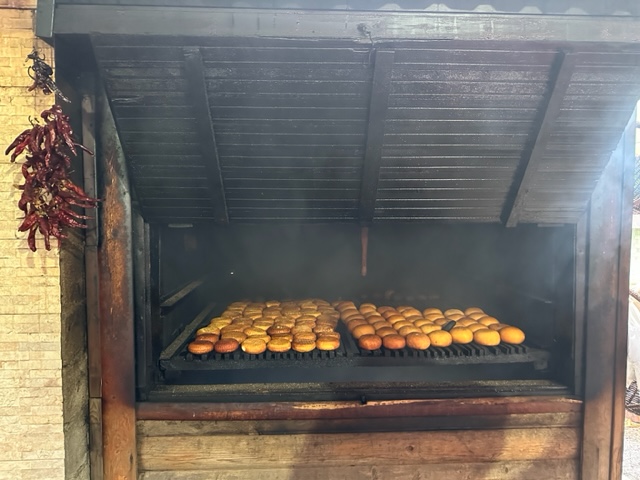
“Six litres of milk are required to produce one kilogramme of cheese. Any milk will do like cow milk, goat or buffalo one, the main thing is that it is fresh, right from the farm and not from the store,” says cheese maker Maxim Bartsits. He was one of the first in Abkhazia to set up a cheese factory on the banks of the Bzyb River and began to show the ancient cheesemaking skill to tourists.
“To make cheese, you need just to heat the milk, if it boils, you get not cheese, but cottage cheese. As soon as bubbles appear on the surface of the milk at the walls of the pot, we pour in thrusting (whey). The milk is curdled, we discard the resulting mass in a colander and let it drain. This is a ‘fresh’ (green) cheese that needs to be soaked in whey brine. The longer the cheese mass is in it, the harder the cheese will be,” explains the cheese maker.
Green cheese can be stored without a refrigerator for seven days. Therefore, to make cheese for the winter, Maxim’s Abkhazian ancestors invented smoking. They do it using chips of alder or fruit trees that do not give bitterness. Two days of smoking is enough for cheese to acquire a beautiful golden crust and be stored for 4-5 months.
“And here is a cheese that is smoked for a month,” - cheese maker Maxim Bartsits says, showing a black piece that looks like a piece of coal, “Such cheese can be stored for five years without a refrigerator. At any moment, it is enough to put it into water, the cheese saturates with moisture and becomes larger. You just need to peel off the black crust and eat the cheese.
The Abkhazians eat cheese with mamaliga (polenta). They put a piece of smoked cheese in hot polenta and eat it. A glass of wine with it would be great. During the “Taste of Abkhazia” tour, the travellers go to the “Wine Jet Abkhazia” winery located in a small village of Kaldakhuara to tase delicious wine. The family winery produces only 20,000 bottles. Someone will be surprised - “Only?”. For Abkhazia, this is not much, especially considering that 700 guests are invited to a wedding party, each guest drinks at least 15 glasses of wine. By the way, the winery is famous although it is a small one. This year, its “Malbek” red wine was recognized as the best among the products of 90 Abkhazian wineries.

“We make white, red and rosé wines. These wines are dry, we don’t call semi-sweet wine even as wine, it is just a wine drink. We use grapes of European varieties - Riesling, Sauvignon, Merlot - and local indigenous (autochthonous) species - Tsolikouri, Amlakhu, Kachich,” says winemaker Leon Akhba. He is only 19 years old and studies at the Abkhaz State University to be a technologist. But he is knowledgeable in wine, as they say, ‘from the cradle’ because this noble drink was made by his grandfather.
In addition to wine, they drink “chacha” - grape-brandy - in Abkhazia and it is a drink like “samogon” (moonshine) in Russia. But chacha doesn’t give a hangover next morning.
“To understand that chacha is real, it is enough to smell it. It shouldn’t smell anything. Neither alcohol, nor grapes,” Leon shares a secret.
Well, the winery’s signature drink is the “Abkhaz Lights” cocktail. To make it, limoncello from Abkhazian lemons is mixed with rosé wine. Believe me, the colours of Abkhazia become much brighter after one glass.
Gold fish
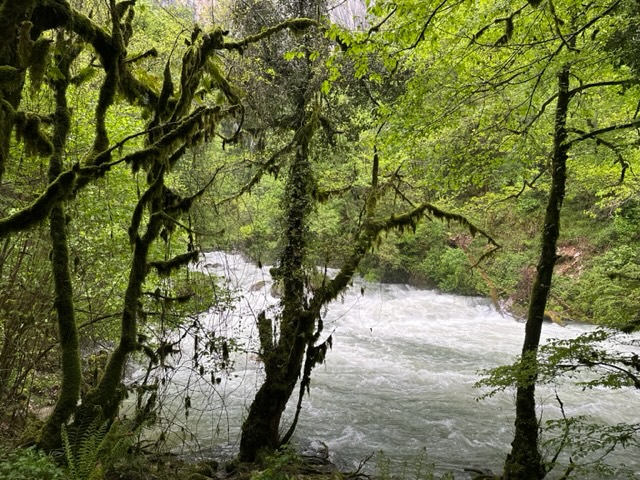
At the place where a stormy river breaks through steep cliffs, in the shade of a centuries-old boxwood forest overgrown with green moss, the “Chernorechenskoye” (Black River) rainbow trout farm was set up in 1934. It still operates here today and black stones are seen through the clear water.
“There is a reason that this place was chosen. The water in the Black River originating in the rocks has a temperature of +9 degrees Celsius all year round. Constant temperature and clean running water are the main conditions for tasty fish to grow, especially for rainbow trout that inhabits only in fresh water,” says ichthyologist and fish farmer Maya Agrba.
Maya has been working at the Chernorechensk rainbow trout farm for more than 50 years. She still remembers the Soviet times when more than 100 tonnes of fish a year were grown at the farm and delivered to all the resorts and health centres of the Republic of Abkhazia. She also remembers how during the Georgian-Abkhazian conflict when the farm ran out of the fish feed, all the fish were sent to refugee centres, and how the decision was made to revive the Abkhazia’s iconic trout farm, how the first fish eggs were obtained at one factory in Nalchik.
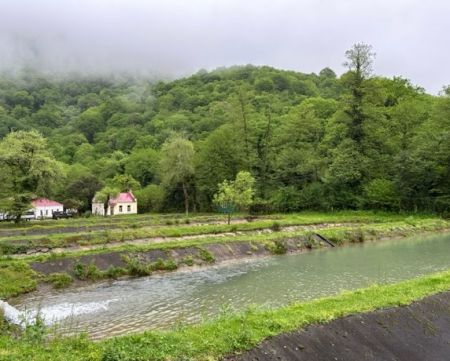
“At our farm, we grow fish from fish eggs to get adult rainbow trout. Since the water temperature is quite cold, the fish juveniles’ incubation period is 33 days. A special fish feed is used for rainbow trout that is produced at an enterprise near Sukhum. 45 percent of the fish feed is fish flour made of anchovy fish, we have plenty of these fish in our sea, as you understand. The fish feed does not contain any growth stimulants, so it takes two years to get a fish weighing half a kilo, explains the ichthyologist.
So far, only a third of the possible pools for growing rainbow trout is used at the Chernorechensky rainbow trout farm. It turns out from 15 to 25 thousand tonnes of fish per year. This is not enough for a republic popular with tourists. Therefore, the farm reconstruction has recently begun. Maya Agrba strongly hopes that soon, the enterprise will reach the Soviet scale, increasingly more tourists will be able to taste delicious rainbow trout. Rumour has it that on one of his vacations, Yuri Gagarin, the first cosmonaut of the world, tasted the rainbow trout at this place.
Not by bread alone
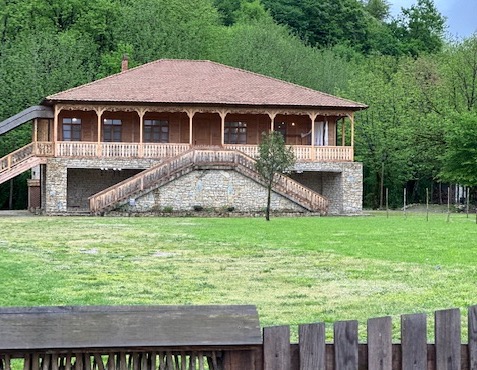
In addition to amazing gastronomic experience during the “Taste of Abkhazia” tour you can get a great cultural experience, too. One of the attractions is the “Apsny” ethnographic park. In the park, the lifestyle of a traditional Abkhaz family is recreated on the area of several hectares, the tourists can get acquainted with the local traditions and culture, admire Abkhazian national costumes, visit a real ‘apatskha’ (traditional Abkhazian house), see the work of craftsmen skilled in forging, pottery and tobacco. Yes, it’s just a pleasure to walk along an unusual river that, contrary to all the laws of gravity, flows from the sea to the mountains.
You can read about other excursions offered by the “Sochi” excursion train at the link
